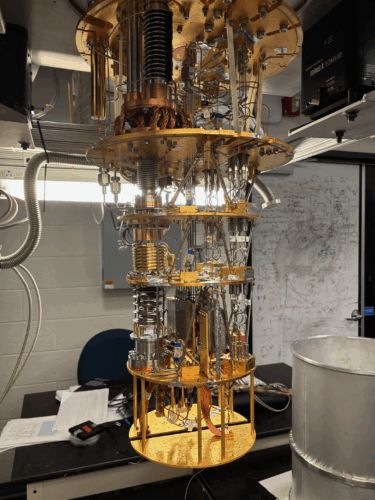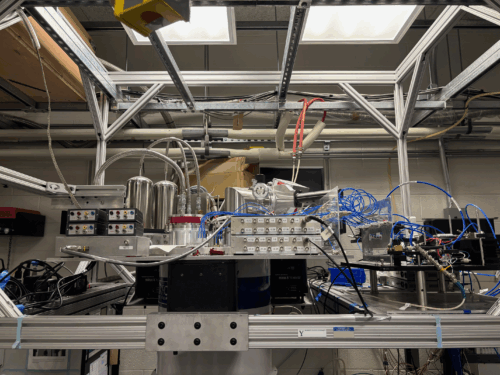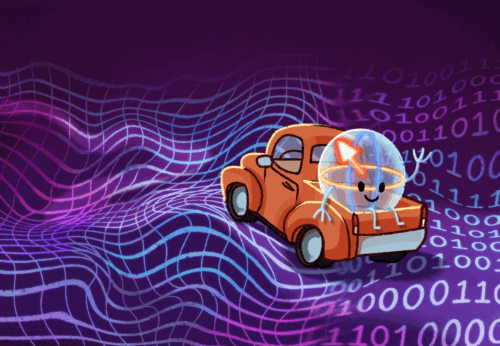Editor’s note: On October 7, the Royal Swedish Academy of Sciences awarded the 2025 Nobel Prize in Physics to John Clarke, Michel H. Devoret, and John M. Martinis “for the discovery of macroscopic quantum mechanical tunnelling and energy quantisation in an electric circuit.” Michel Devoret is the Frederick W. Beinecke Professor Emeritus of Applied Physics at Yale, where he has served as a faculty member since 2002. This article presents the breakthrough work that Devoret’s group at Yale published in Nature in May 2025.
The digital world is made of bits, the simple binary language of zeros and ones. Every photo, text, video, file, and program on your devices boils down to long strings of binary digits—on or off, high or low. But what if we could process information more efficiently, in more than just two states? Quantum physics may hold the answer.
In classical physics, objects have a fixed position, or state, which remains unchanged with observation. But in the world of quantum physics, objects can exist in a blend, or “superposition,” of many states at once, only collapsing to one when measured. A “quantum bit” or “qubit” formalizes this idea, allowing a digit to exist as both zero and one at the same time. But now, scientists at the Yale Quantum Institute have broken beyond this binary barrier completely. Their focus is on qudits, quantum systems that can exist in more than two states at once. A qudit can take on three states (a qutrit), four states (a ququart), or even more states at once. If qubits are coins with two sides, qudits are dice, tetrahedra, or even stranger geometric objects that stretch imagination and mathematics alike. And yet, as Michel Devoret, Frederick W. Beinecke Professor Emeritus of Applied Physics at Yale and winner of the 2025 Nobel Prize in Physics, pointed out, even that analogy doesn’t quite capture the full complexity. “A qubit is already more powerful than a bit. In geometry language, if a bit is two points, the qubit is a sphere,” Devoret said. “When you move to ququarts, with four levels, the geometry is a sphere in seven dimensions.”
The concept may be abstract, but the advantages are tangible. Higher-dimensional systems can make quantum algorithms more efficient, enable better error correction, and ultimately lead to more powerful computers. This leap from the binary world into higher-dimensional quantum space is exactly what Devoret and Benjamin Brock, a postdoctoral researcher in Devoret’s lab, achieved in a landmark experiment published in Nature in May 2025. For the first time, scientists demonstrated quantum error correction not just for qubits, but for qudits, pushing the frontier of what quantum computers can be.
The Fragility Problem
Quantum computers hold dazzling promises, from simulating new designs for medicines to cracking codes once thought unbreakable. But there’s a catch: quantum states are extraordinarily fragile. The faintest whisper of environmental “noise”—a stray photon, a tiny vibration, or even a slight change in temperature—can collapse a carefully prepared quantum state into useless static.
This fragility is why quantum error correction, or QEC, is the holy grail of the field. In everyday life, you already benefit from error correction: when a CD gets scratched, or when data zips across the internet, extra bits of information are embedded so that the system can detect and repair mistakes before you ever notice them. The computer doesn’t need to resend the whole email—it simply repairs the corrupted pieces. Translating that idea into the quantum world, however, is far trickier: scientists can’t simply copy quantum states, and each additional patch introduces its own opportunities for failure.
The ultimate benchmark is known as “beyond break-even,” the point where error-corrected quantum information survives longer than the best unprotected encoding. Now, Brock and his team have achieved this elusive milestone for the much more complex world of qudits.
Going Beyond Binary
So why gamble on qudits at all, if qubits already seem to be such a tough nut to crack? Devoret explained the motivation by drawing a contrast with classical computing. “In classical information, it doesn’t pay off to increase the number of states,” he said. “But in quantum mechanics, it’s completely different. Qutrits and ququarts can actually be more powerful, especially in error correction.” Most real-world quantum devices naturally have more than two energy levels available, but the extra states are usually ignored or even treated as nuisances. Brock and Devoret’s research flips that perspective: instead of suppressing those levels, why not harness them?
By encoding information in qutrits and ququarts, the team behind the recent experiment showed that higher-dimensional systems can be stabilized using a specialized tool called the Gottesman-Kitaev-Preskill bosonic code. This method distributes quantum information across many possible states of light within a cavity so that small errors can be detected and corrected. The payoff of this method was striking: error-corrected logical qutrits and ququarts survived about eighty percent longer than their uncorrected counterparts, a clear demonstration of beyond break-even error correction.
But getting there was anything but straightforward. One of the thorniest challenges was figuring out how to actually measure the state of a qutrit using only the binary “yes-or-no” outcomes. For months, the problem nagged at Brock. Then, unexpectedly, the solution struck him—not in the lab, but behind the wheel. “I was working on this for months and months, not figuring out how to read out the state of a logical qutrit,” he said. “I came up with the circuit on a long car ride.” That breakthrough circuit allowed the team to finally demonstrate logical measurements for qutrits, unlocking the path to full error correction. “Even as we stored more information, we were storing it more robustly with quantum error correction than we could without it,” Brock said.

Circuits and Resonators
Finding a circuit that could map the results of a qutrit onto a qubit was not only paramount to the quantum error correction process, but also to the computer itself. The whole device consists of two physical systems whose behaviors are linked. The first is a cylindrical device called a microwave cavity, which represents the qutrit or ququart. To understand, picture the cavity as an acoustic instrument. Just as a cello string can vibrate at a fundamental note along with its higher harmonics, the cavity sustains electromagnetic waves that resonate at specific frequencies. These frequencies are like the instrument’s notes. By carefully tuning and controlling them, the team could use the cavity as a quantum “resonator” to store and manipulate quantum information.
As an isolated device, however, the microwave cavity had a limitation. “You can’t control its state arbitrarily,” Brock said. In this linear cavity, energy levels are evenly spaced, like the rungs of a ladder. That uniformity creates a fundamental challenge. “You can’t drive transitions, for example, between the zero and the one state, because that’s the same frequency as the one to the two state,” Brock said. The transitions are the “jumps” a photon can make between energy levels, and each jump requires a very specific frequency of electromagnetic waves—similar to how a swing only moves higher if you push it in rhythm with its natural motion. Because the spacing between the “rungs” is identical, the same “push” doesn’t just excite one jump—it sets off many at once. In other words, you end up climbing the whole ladder at once.
That is where another device, called a transmon qubit, comes in. Its inner circuitry is complicated, but thanks to some clever superconductivity physics, it has energy levels that are unevenly spaced and can be manipulated in isolation. By coupling the transmon qubit to a microwave cavity, the qudit’s state can be copied to the transmon, where it can be measured and controlled correctly, resolving the “rung” problem and allowing information to be mapped correctly.
Feynman’s Dream
As Brock and Devoret’s challenges illustrate, the barriers that stand in the way of advancements in computing often turn out to be physical, not theoretical. Classical computers tend to run into problems of time, processing power, and accuracy of data, among others. Quantum computers may be able to overcome some of these barriers. One of the first to articulate this vision was Devoret’s Nobel Prize–winning peer Richard Feynman, who in the 1980s argued that if nature itself runs on quantum rules, then simulating it efficiently would require a computer that also obeys quantum mechanics. If that’s true, then quantum computers could become powerful new tools for exploring the deepest questions in chemistry, physics, and biology. What sort of applications might await us?
There is still much more work to be done to reach the idealized computer of Feynman’s dream. For now, qudits seem promising. Their advantage lies in their ability to save space and create more efficient computer architecture. Consider this: conventionally encoding one hundred individual qubits would require one hundred separate physical systems—a setup that is completely impractical. If scientists can overcome the fragility of qudits, they could massively simplify large computing networks.
“One of the interesting things I really think would be a very cool idea building off this work is taking a logical qudit—in particular, a ququart—and embedding another layer of error correction within it,” Brock said. He suggested that one possible direction would be to embed a qubit within two of the logical states of a ququart, which itself resides in a resonator. This approach would create multiple layers of error correction within a single physical system—an idea that, he noted, is not only conceptually elegant but also potentially very practical.
With each dimension explored, each break-even point reached, and each computer architecture optimized comes a new milestone passed in the journey of quantum computing. Progress is quick; what is only theory today could be built in a lab tomorrow. Physicists are building the framework for revolutionary computers—ones that will weave data into mammoth webs of connections and calculations unlike anything ever seen before.


